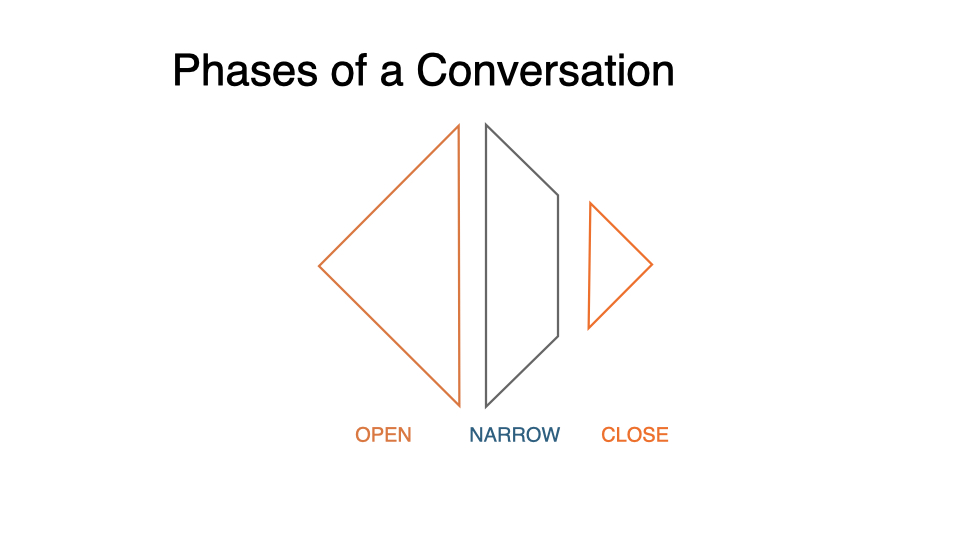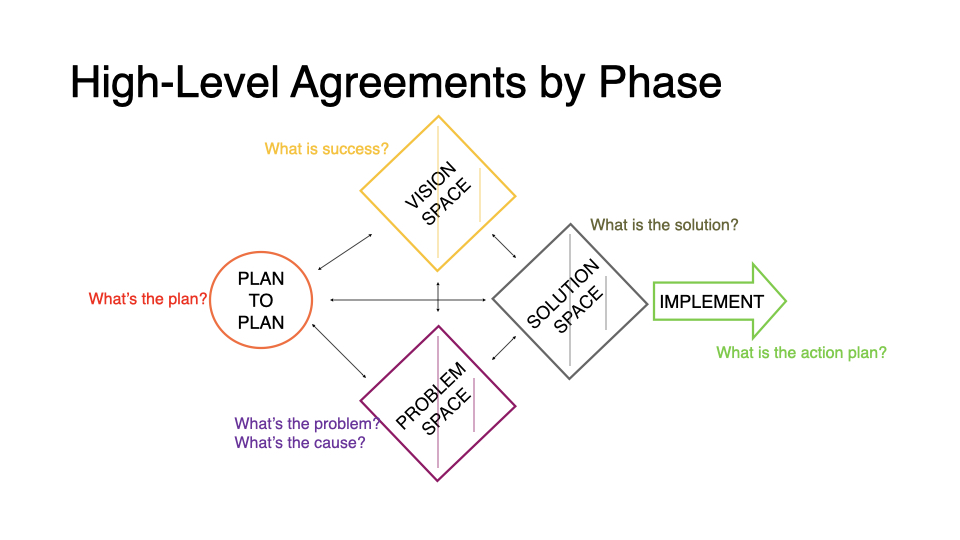Overview
The purpose of this blog post series is to provide conceptual frameworks and practical tools that improve your performance as a leader. Emerging best practices in AEC operations, driven by lean, operations science and progressive design-build, require us to rethink leadership. No matter where you are in your organization, whether you are a construction crew or design/engineering team member, a foreman or project manager, or a corporate executive, this High-Performance Leadership tool kit will help you.
Objective
In this tenth and final post, we present more of what you need to know to become a High-Performance Leader. In this post we finish the discussion of collaborative problem solving started in HPL Post #9. This post presents a facilitator’s roadmap for a series of small agreements that lead to a solid final agreement.
High Performance Leadership: Facilitation of Collaborative Problem Solving
Welcome back to this High-Performance Leadership Blog Series. If you have not read Posts 1-9 yet, please consider doing so. They will set the stage for this last discussion.
In post #9 we asserted that problem solving is all about changing an unsatisfactory current situation into a better situation.
Remember, if you don't agree on the problem, you probably won't agree on the solution. Big agreements on the problem and the solution can fall apart when we fail to build a foundation of smaller agreements, including:
- Is this a problem situation that needs to be addressed now?
- Do we sufficiently understand the situation, its important elements and causes?
- Do we have a clear, compelling definition of the issue(s) to be addressed?
- Have we envisioned and agreed on what success should look like?
- Has that vision of success been turned into clear Conditions of Satisfaction (COS) and success criteria by which we can measure the results of our new actions?
- Have we identified all the solution/improvement options we should consider?
- Have we evaluated those options to understand the relative advantages/value of each?
- Have we agreed on solutions/improvements to recommend for implementation?
- Have we committed ourselves to an implementation plan?
These agreements become the building blocks for a solid commitment to action.
Leaders must plan and facilitate many discussions and activities that build team commitment. Each major discussion topic - problems and causes, our vision of success, possible solutions, and implementation commitments, requires focused, productive collaboration. The High-Performance Leader must be clear which topic areas will be addressed, in which order. They must plan to generate the information or action needed at each step and focus on the agreements needed at each problem-solving meeting.
Each area of focus -- Problem, Vision, Solution - goes through the 3 Phases of a Conversation.

Interaction Associates, a developer of advanced facilitation and collaboration leadership skills training, developed the two models presented above and below. The diamond-shaped model above depicts the discussion phases of each major problem-solving topic: Problem, Vision, Solution. For example, to get to an agreement on what the problem is, we need to generate information about the situation. The Leader/Facilitator uses processes and tools that create an open, curious, creative space where ideas and experiences are shared and captured. The process should generate useful information including both personal perceptions/experiences, and hard data. Next, we need to understand and organize that information to make sense of it and identify what is important. The narrowing process requires analytical thinking, more like Sherlock Holmes. Finally, we need to close the discussion with agreements on a problem definition and summary. This takes Win/Win thinking and decision-making skills, discussed earlier in this series.
The facilitative leader must be clear which topic we are working on, which phase of the discussion we are in, and which facilitation tools will be deployed to keep the discussion on topic, and productive. Imagine planning a cross-country trip. The High-Performance Leader must zoom out to the national map to choose a route and measure progress toward the ultimate destination, then zoom in to the state map to assess upcoming terrain, and then zoom in further to plan the next couple of hours of driving.
The problem-solving roadmap below helps us plan a journey through definition and analysis of the current situation and it's causes. It helps us envision an improved situation and agree on the solution(s) that must be implemented. It gets from where we are to where we want to be. Most importantly, through these steps, we build commitment to take corrective actions.
Here is the big "roadmap" developed by Interaction Associates, to help us create an initial route, track our progress using a series of agreements as milestone markers and safely navigate the upcoming terrain.

Think of each of the elements (circle, diamonds, arrow) as geographic spaces we are going to travel through -- mental "spaces" that each have a specific focus (terrain) we must navigate. Let's discuss each space.
Plan to Plan
This circle can be thought of as the Leader's rest area along the journey. We start here to plan the route we think will get us to a perfectly implemented solution. We can come back to this safe area to rest and adjust our plan any time road conditions require a detour or a visit to some local attraction. You cannot lead without a plan, even if the plan gets changed.
Note that the arrows between each space are bi-directional suggesting that A) we can always go back and adjust the process/plan, and B) that what we learn in each discussion space will likely influence what we must consider in each other discussion space.
Choose the route through the spaces to fit the problem. Sometimes we must start by understanding the problem and its causes. An example might be a team working to understand and correct reasons for plan failures on their Last Planner System® weekly work plan. Other times, particularly during Design, we start with an extensive Visioning process that identifies desired client and team Conditions of Satisfaction at both broad and detailed design levels. What we envision will no doubt raise challenges and problems that will send us back into problem identification before we can finalize design solutions. Agility is needed. There is a big difference between entering one of these spaces for the first time and a brief return to previous agreements to make an upgrade.
Problem Space
The Open/Narrow/Close (O/N/C) process for the Problem Space is organized to help us arrive at three sub-agreements that complete our problem definition work. These Phases can be called, Data/Perception Gathering, Data Organization/Analysis, and Definition. You know you have completed each of the phases within the Problem Space when your reach each of the following agreements:
1. The stakeholders agree that we have generated enough information to confirm there is a problem worth working on; one we commit our time and resources to fix. The High-Performance Leader must make sure the perspectives and experience of each stakeholder have been captured. (Note: this first agreement is often skipped under the assumption that being assigned to work on a problem = agreement and commitment. It is important to check that each team member agrees to work together for a solution. This will avoid resistance and poor or unequal assignment performance going forward.)
2. The stakeholders agree that we have adequately organized and analyzed the data we gathered and now understand the problem situation and its root causes.
3. We agree on a clear, well-organized problem statement. (The final products of the phase are the problem statement and the agreements.)
Don't be afraid to add to or correct your problem definition as you learn more. Often, some desired Condition of Satisfaction or proposed solution will expose some new constraint (problem/challenge) that further informs and refines your problem statement.
Vision Space
The O/N/C process again will require organizing information and turning it into some written statement of Conditions of Satisfaction for a desired future state. The nature of the exercise requires creative thinking. We are identifying desirable possibilities, features, performance levels, etc., not observing current facts. The personality types and preferences of participants will come into play. Some folks will gravitate almost immediately toward reasons why something can't happen rather than seek to first understand the value an envisioned feature might generate. The High-Performance Leader must accommodate different preferences and tolerances for creative vs. analytical thinking. Both are needed.
You will know you have completed each phase within the Vision Space when you reach the following agreements:
1. All the stakeholders agree that we have identified the desired features, characteristics and performance measures we want to achieve.
2. All the stakeholders agree on a set of Conditions of Satisfaction that define our envisioned results and conditions
3. All stakeholders are committed to creating the desired future state and results.
The High-Performance Leader should keep in mind that clarity about the envisioned Conditions of Satisfaction will provide important criteria by which alternate solutions can be evaluated.
Solution Space
The AEC industry necessarily has a "Git 'er Done" culture. A shadow side of this orientation is that many stakeholders will be impatient to jump right to a solution - usually a pet solution that meets their individual needs. During Problem Definition you may hear people say, "the problem is that we are not doing...X" where "X" is their preferred solution. Leaders must distinguish between a problem definition and a thinly veiled solution proposal. Sometimes we must go slow to go fast. Again, if you don't agree on the problem, you probably won't agree on the solution! When, during problem definition, you encounter a proposed solution in search of a problem, create a list of possible solutions that will be considered now in the Solution Space.
The O/N/C phases for the Solution Space can be called Generate Alternatives, Evaluate, and Decide. You will know you have completed each of the phases within the Solution Space when you reach each of the following agreements:
1. All the stakeholders agree that they have generated alternative solutions that are likely to meet the envisioned COS and address the root causes of the current problem situation.
2. All the stakeholders agree that they understand the relative value of each solution option and have selected or combined the best value-generating solutions.
3. All the stakeholders agree on the best solution, or combination of solutions, necessary to solve the problem and create the envisioned benefits.
Implement Space
1. All the stakeholders agree on an implementation plan
2. All the stakeholders agree to actively support implementation by supplying the necessary resources and production management support to assure success.
So, there is your set of interim agreements that will build a solid final agreement. Problem solving should always be a collective learning experience. The best way to learn is to listen with curiosity and purpose. When there is disagreement, as there should be when there are multiple perspectives, listen for and ask about what is important to each person. Each expressed opinion or strongly held position is in some way, a form of advocacy for something that person values. When we understand the underlying values being promoted, we can check to see how many other stakeholders share those values. Shared values unify a team even when different ideas are being expressed. By asking, "How can we create a solution that best addresses all these values?", we stimulate inclusive, Win/Win thinking. Solutions created with this mindset are often more elegant and more effective. Don't be afraid to revisit and tweak any of the above agreements to reflect what you are learning and developing together.
Please refer to HPL Blog Post #5 for a list of facilitation tools that can be used to help you navigate the Open/Narrow/Close phases of any discussion. A detailed description of the facilitation tools most often used to Open/Narrow/Close the process for each Space would take too much room for a blog post. A pdf. version of the ppt. slides used in HPL live trainings is available on request at vicortiz@earthlink.net. Those slides provide detailed descriptions of each facilitation tool, examples and suggestions.
You might want to develop a list of your own key take-aways from each of these ten High-Performance Leadership blog posts. As a parting gift, and to say thanks for reading these posts, here are my key take-aways for you:
- Leadership doesn't happen in a vacuum. It happens through interaction with others. How you interact with others will make or break your leadership effectiveness.
- Every interaction where business is transacted, whether one-on-one, in a small production group, or a large project or company gathering, should be thought of as a meeting.
- If you cannot define the Purpose and Desired Outcomes of your interaction, if you don't have a plan (agenda) to accomplish what needs to be done, you are not ready to meet.
- More than 90% of what people complain about in meetings or on projects has to do with process problems; yet most of us are process blind. The more you develop your process awareness and build your process tool kit, the more effective you will be at leading technical and strategic operations.
- Develop your facilitation and interpersonal skills.
- People help implement what they helped to create. Learn to identify the different types of stakeholders for each major issue and project phase. To get great execution and commitment, get the right people in the right place at the right time. Build a stakeholder engagement plan.
- Commit to getting Win/Win decisions as much as possible. Get people to listen to and understand what each stakeholder needs. Challenge them to create elegant solutions that meet as many of those needs as possible. You will greatly improve solution quality.
- Big agreements are built through a series of small agreements. In the first 5 minutes of any discussion, if you can get agreements on the Purpose, Desired Outcomes and Agenda, formally or informally, you will have established a positive, collaborative norm.
- There is no upper limit to how much you can improve your leadership skills. Stay curious. Stay joyful. Stay grateful for every lesson learned. Your errors can be your best mentors.
I hope these ten posts have been helpful in some way and that you will continue your personal pursuit of excellence. I wish you every success.
For more information about facilitation tools and HPL training materials, contact: vicortiz@earthlink.net
